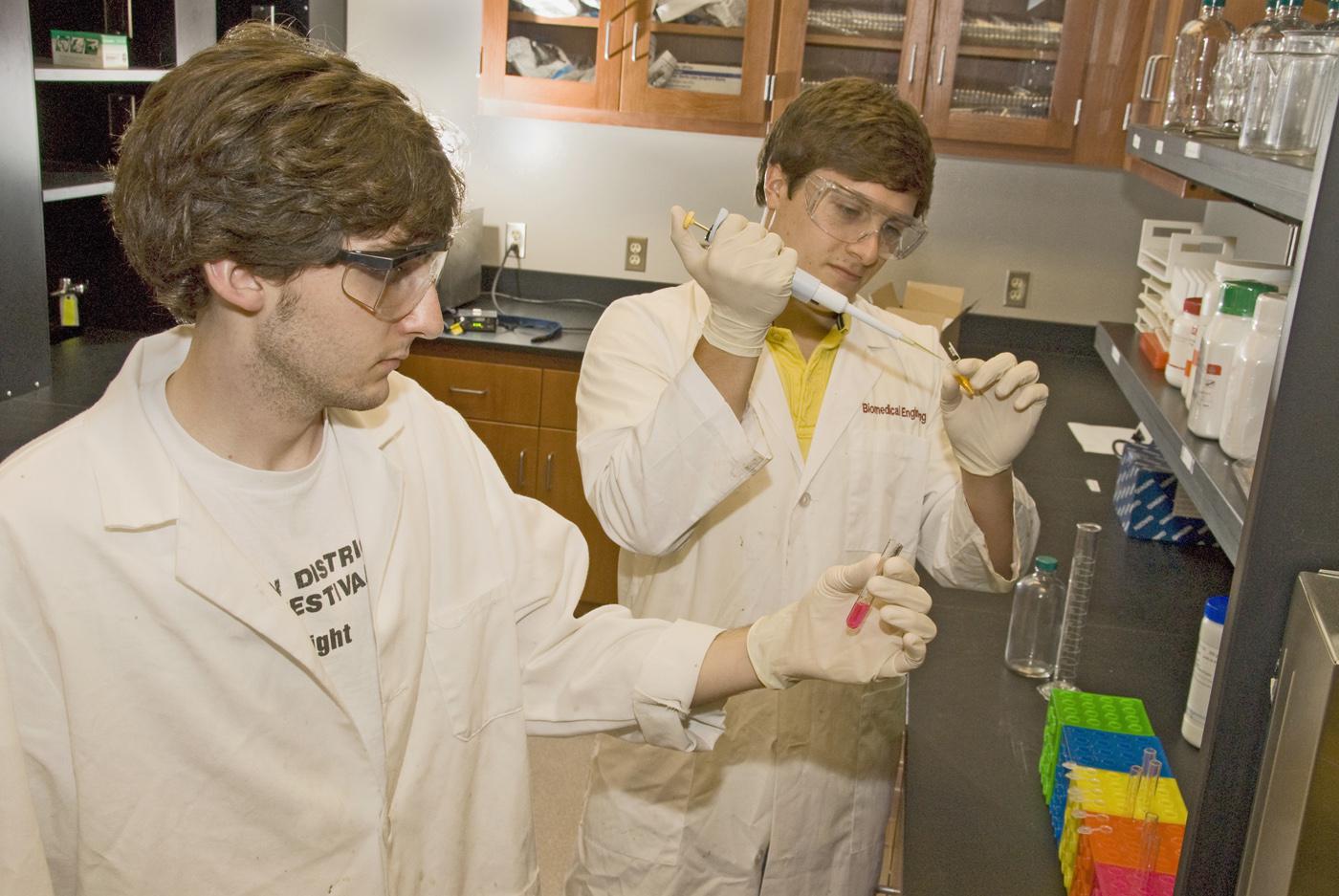Information Possibly Outdated
The information presented on this page was originally released on December 11, 2008. It may not be outdated, but please search our site for more current information. If you plan to quote or reference this information in a publication, please check with the Extension specialist or author before proceeding.
MSU students lay waste to biomass-as-fuel obstacle
By Patti Drapala
MSU Ag Communications
MISSISSIPPI STATE -- Plant waste offers a nearly unlimited supply of raw material for biofuel production, but the substance that stands in the way of its use is the same one that makes the plants stand.
The substance in question is lignin, a biopolymer that gives plant cells their structure and resistance to degradation. Mississippi State University biological engineering undergraduates Caleb Dulaney and Sam Pote are determined to help the world rethink biomass possibilities “one cell at a time” with their research on isolating a naturally occurring enzyme that initiates lignin breakdown.
The two students won a bronze medal in November for their work at the 2008 International Genetically Engineered Machine, or iGEM, competition among 84 universities held at the Massachusetts Institute of Technology in Cambridge. MSU's team competed in the energy category. Student teams that earn a bronze, silver or gold medal also receive the honor of entering their research into the Registry of Standard Biological Parts.
“This honor recognizes our team's accomplishment,” said MSU biological engineering professor Filip To, one of the team's faculty advisers. “It shows we have a presence and strength in this new knowledge of synthetic biology and it means that our students are as world-class in their fields as those at many elite schools with strong financial backing.”
The cellulose and hemi-cellulose in plant cells can be converted to sugar for making ethanol. However, these materials cannot be accessed without breaking down the lignin. Many manufacturers are unwilling to perform the process needed to break down lignin in biomass because it is costly and complex.
While some food crops, such as corn, soybeans and sugar cane, provide materials for making ethanol and other biofuels, using these important commodities to make biofuel puts a strain on the world's food supply.
“The problem with the current way of making ethanol is that resources are limited,” said Dulaney, a senior from Collinsville. “The plant matter left over after harvesting can provide an almost unlimited resource for biofuel manufacturing.”
Harsh chemicals are needed to break down lignin and the process is complicated. The chemical residues only add to the overall waste disposal problems that industries deal with.
“If an accelerated biological process to break down lignin were possible, there would be less of a problem for the environment,” Dulaney said.
Dulaney received a fellowship from the MSU Shackouls Honors College to work on a research project as a member of the MSU Synthetic Biology Team. The team, which also included Pote, a Starkville junior, and MSU biochemistry professor Din-Low Ma, had a goal of isolating an enzyme-producing gene in white-rot fungi that initiates lignin breakdown.
“Dr. To heard about the iGEM competition four years ago, and he talked with several students before he went to MIT to observe,” Pote said. “He brought back several ideas, and we talked about participating in the event.”
MSU sent student teams to the competition in 2006 and 2007. The 2006 team won honorable mention for investigating the use of Escherichia coli, or E.Coli, to make a hydrogen detector. The 2007 team won a bronze medal for its investigation in tracking abnormal cell growth by marking a substance called eubiquitin.
After considerable discussion with advisers, the two students decided to research alternative material sources for biofuel for the 2008 competition. The white-rot fungus, often found on rotting wood, contains a peroxidase enzyme that contributes to lignin breakdown. Two other enzymes complete the process.
“We chose lignin-degrading peroxidase because it initiates the breakdown,” Dulaney said. “The other enzymes break away the lignin from the plant material and further break up the material.”
The first step of the research was to isolate the enzyme-producing gene. The second was to introduce the gene into E. coli to reproduce it. Dulaney and Pote enlisted the help of graduate students Robert Morris and Meng-Hsuan “Victor” Ho to accomplish this goal.
“We were looking for a natural and environmentally friendly way to break down the lignin at a faster rate,” Pote said. “Our work on the project allowed us to isolate the gene, slice out the DNA and basically have the bacteria eat the lignin.”
The students said they enjoyed the research because they were able to focus on the engineering of a biological process, a concept both wanted to master.
“Our research project is definitely an indication that science and industry are giving more thought to moving away from petroleum-based energy,” Pote said. “We feel like we have taken our first step to make people aware of the possibility.”
Contact: Dr. Filip To, (662) 325-3282





